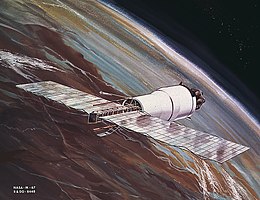Pegasus 1
 A Pegasus satellite in orbit | |
| Mission type | Micrometeoroid detection |
|---|---|
| Operator | NASA |
| COSPAR ID | 1965-009A |
| SATCAT no. | 001085 |
| Mission duration | 3 years 6 months 13 days |
| Spacecraft properties | |
| Spacecraft type | Fairchild Hiller |
| Launch mass | 10,297 kilograms (22,701 lb) |
| Payload mass | 1,450 kilograms (3,200 lb) |
| Start of mission | |
| Launch date | 16 February 1965 |
| Rocket | LC-37B |
| End of mission | |
| Disposal | Decommissioned |
| Deactivated | 29 August 1968 |
| Decay date | 17 September 1978 |
| Orbital parameters | |
| Reference system | Geocentric |
| Regime | Low Earth orbit |
| Perigee altitude | 500 kilometers (270 nmi) |
| Apogee altitude | 731 kilometers (395 nmi) |
| Inclination | 31.7 degrees |
| Period | 97.00 minutes |
| Epoch | 18 March 1965 |
Apollo micrometeoroid investigation | |
Pegasus 1 or I, known before launch as Pegasus A, was an American satellite which was launched in 1965 to study
Spacecraft
Pegasus 1 was a Pegasus satellite, consisting of 1,450 kilograms (3,200 lb) of instruments, attached to the S-IV upper stage of the carrier rocket which had placed it into orbit.[1] It had a total mass of 10,297 kilograms (22,701 lb),[2] and was equipped with two sets of micrometeoroid detection panels, and a radio for tracking and returning data.[1] The panels were 29 meters (95 ft) long, and equipped with 116 individual detectors.[3]
Launch

Pegasus 1 was launched atop a
Pegasus 1 was a secondary payload of
The trajectory and space-fixed velocity were very nearly as planned. The Apollo shroud separated from the Pegasus satellite about 804 seconds after lift-off and deployment of two meteoroid detection panel wings of the Pegasus satellite commenced about 1 minute later.
Operations
Pegasus 1 was operated in a low Earth orbit. On 18 March 1965 it was catalogued as being in an orbit with a
See also
References
- ^ a b c d Krebs, Gunter. "Pegasus 1, 2, 3". Gunter's Space Page. Retrieved 20 December 2010.
- ^ "World Civil Satellites 1957-2006". Space Security Index. Archived from the original on 18 July 2011. Retrieved 20 December 2010.
- ^ Wade, Mark. "Pegasus". Encyclopedia Astronautica. Archived from the original on June 12, 2002. Retrieved 20 December 2010.
- ^ McDowell, Jonathan. "Launch List". Launch Vehicle Database. Jonathan's Space Page. Retrieved 20 December 2010.
- ^ a b McDowell, Jonathan. "Launch Log". Jonathan's Space Page. Retrieved 20 December 2010.
- ^ "Pegasus 1". NSSDC Master Catalog. US National Space Science Data Center. Retrieved 20 December 2010.
- ^ a b McDowell, Jonathan. "Satellite Catalog". Jonathan's Space Page. Retrieved 20 December 2010.
